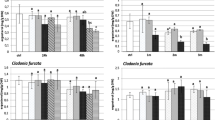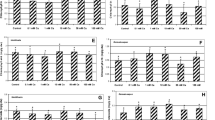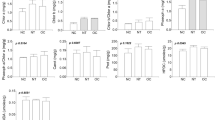Abstract
In this study we focused on the comparison of the physiological responses to excess nitrogen (N) comparing Cladonia arbuscula subsp. mitis and Cladonia furcata. Both lichens were exposed to increased amounts of nitrogen (NH4NO3) for five weeks. Different concentrations of nitrogen were applied by spraying the lichen thalli during this period. After the treatment, the physiological parameters of the lichen, like chlorophyll a fluorescence, chlorophyll b integrity, content of soluble proteins, ergosterol, thiobarbituric acid reactive substances (TBARS) and content of secondary metabolites were measured. We found out that lichens responded differently to nitrogen excess concerning photobiont and mycobiont. The mycobiont of C. arbuscula subsp. mitis seems to be more sensitive to the nitrogen excess than C. furcata based on decreased ergosterol content. We concluded that the mycobiont is more sensitive to nitrogen excess than the photobiont in case of the tested lichen species in a middle term experiment.
Similar content being viewed by others
Abbreviations
- HPLC:
-
high performance liquid chromatography
- TBARS:
-
thiobarbituric acid reactive species
- TCA:
-
trichloracetic acid
- PhQ:
-
phaeophytinization coefficient
References
Bačkor M., Kováčik J., Dzubaj A. & Bačkorová M. 2009. Physiological comparison of copper toxicity in the lichens Peltigera rufescens (Weis) Humb. and Cladina arbuscula subsp. mitis (Sandst.) Ruoss. Plant Growth Regul. 58: 279–286.
Bradford M. M. 1976. A rapid and sensitive method for quantitation of microgram quantities of protein utilizing of protein utilizing the principle of protein-dye binding. Analyt. Bioch. 72: 248–254.
Dahlman L., Näsholm T. & Palmqwist K. 2001. Growth, nitrogen uptake, and resource allocation in the two tripartire lichens Nephroma arcticum and Peltigera aphthosa during nitrogen stress. New Phytol. 153: 307–315.
Dahlman L., Zetherström M., Sundberg B., Näsholm T. & Palmqvist K. 2002. Measuring ergosterol and chitin in lichens, pp. 348–362. In: Kranner I., Beckett R. & Varma A. (eds), Protocols in Lichenology: Culturing. Biochemistry. Ecophysiology and Use in Biomonitoring. Springer Verlag. ISBN: 3-540-41139-9.
Hauck M. 2010. Ammonium and nitrate tolerance in lichens. Environ. Poll. 158: 1127–1133.
Hauck M., Helms G. & Friedl T. 2007. Photobiont selectivity in the epiphytic lichens Hypogymnia physodes and Lecanora conizaeoides. Lichenologist 39: 195–204.
Johansson O., Nordin A., Olofsson J. & Palmqwist K. 2010. Responses of epiphytic lichens to an experimental whole-tree nitrogen-deposition gradient. New Phytol. 188: 1075–1084.
Loppi S. & Nascimbene J. 2010. Monitoring H2S air pollution caused by the industrial exploitation of geothermal energy: The pitfall of using lichens as bioindicators. Environ. Poll. 158: 2635–2639.
Makkonen S., Hurri R.S.K. & Hyvärinen M. 2007. Differential responses of Lichen symbionts to enhanced nitrogen and phosphorus availability: An experiment with Cladina stellaris. Ann. Bot. 99: 877–884.
Maslaňáková I., Biľová I., Goga M., Kuchár M. & Bačkor M. 2015. Differences between sensitivity of mycobiont and photobiont of Cladonia sp. lichens to different types of nitrogen exposure. Water Air Soil Poll. 226: 243.
Munzi S., Pirintsos S. A. & Loppi S. 2009a. Chlorophyll degradation and inhibition of polyamine biosynthesis in the lichen Xanthoria parietina under nitrogen stress. Ecotoxicol. Environ. Safety 72: 281–285.
Munzi S., Pisani T. & Loppi S. 2009b. The integrity of lichen cell membrane as a suitable parameter for monitoring biological effects of acute nitrogen pollution. Ecotoxicol. Environ. Safety 72: 2009–2012.
Munzi S., Pisani T., Paoli L. & Loppi S. 2010. Time-and dosedependency of the effects of nitrogen pollution on lichens. Ecotoxicol. Environ. Safety 73: 1785–1788.
Nash III T.H. 2008. Lichen Biology. Second Edition. USA, NY: Cambridge University Press, ISBN 978-0-521-69216-8.
Nimis P.L. & Martellos S. 2008. ITALIC-The information System on Italian Lichens. Version 4. 0. University of Trieste, Dept. of Biology, IN4.0/1 https://doi.org/dbiodbs.univ.trieste.it/
Nybakken L., Johansson O. & Palmqwist K. 2009. Defensive compound concentration in boreal lichens in response to simulated nitrogen deposition. Global Change Biol. 15: 2247–2260.
Ochoa-Hueso R. & Manrique E. 2011. Effects of nitrogen deposition and soil fertility on cover and physiology of Cladonia foliacea (Huds.) Willd., a lichen of biological soil crusts from Mediterranean Spain. Environ. Poll. 159: 449–457.
Paoli L., Pirintsos S.A., Kotzabasis K., Pisani T., Navakoudis E. & Loppi S. 2010. Effects of ammonia from livestock farming on lichen photosynthesis. Environ. Poll. 158: 2258–2265.
Paoli L., Corsini A., Bigagli V., Vannini J., Bruscoli C. & Loppi S. 2012. Long-term biological monitoring of environmental quality around a solid waste landfill assessed with lichens. Environ. Poll. 161: 70–75.
Pawlik-Skowro´nska B. & Bačkor M. 2011. Zn/Pb-tolerant lichens with higher content of secondary metabolites produce less phytochelatins than specimens living in unpolluted habitats. Environ. Exp. Bot. 72: 64–70.
Pirintsos S.A., Munzi S., Loppi S. & Kotzabasis K. 2009. Do polyamines alter the sensitivity of lichens to nitrogen stress? Ecotoxicol. Environ. Safety 72: 1331–1336.
Pisani T., Munzi S., Paoli L., Bačkor M., Kováčik J., Piovár J. & Loppi S. 2010. Physiological effects of mercury in the lichens Cladonia arbuscula subsp. mitis (Sandst.) Ruoss and Peltigera rufescens (Weiss) Humb. Chemosphere 82: 1030–1037.
Ronen R. & Galun M. 1984. Pigment extraction from lichens with dimethylsuloxide (DMSO) and estimation of chlorophyll degradation. Environ. Exp. Bot. 24: 239–245.
Skaloud P. & Peksa O. 2010. Evolutionary inferences based on ITS rDNA and actin sequences reveal extensive diversity of the common lichen alga Asterochloris (Trebouxiophyceae, Chlorophyta). Mol. Phylog. Evol. 54: 36–46.
Thormann M.N. 2006. Lichens as indicators of forest health in Canada. Forestry Chronicle 82: 335–343.
Wellburn A.R. 1994. The spectral determination of chlorophylls a and b, as well as total carotenoids, using various solvents with spectrophotometers of different resolution. J. Plant Physiol. 144: 307–313.
Author information
Authors and Affiliations
Corresponding author
Rights and permissions
About this article
Cite this article
Králiková, I., Goga, M., Biľová, I. et al. Response of lichens Cladonia arbuscula subsp. mitis and Cladonia furcata to nitrogen excess. Biologia 71, 632–638 (2016). https://doi.org/10.1515/biolog-2016-0078
Received:
Accepted:
Published:
Issue Date:
DOI: https://doi.org/10.1515/biolog-2016-0078




